
About Andrew Cusack
 Writer, web designer, etc.; born in New York; educated in Argentina, Scotland, and South Africa; now based in London.
Writer, web designer, etc.; born in New York; educated in Argentina, Scotland, and South Africa; now based in London. read more
News
Blogs
Reviews & Periodicals
Arts & Design
World
France
Mitteleuropa
Knickerbockers
Argentina
The Levant
Africa
Cape of Good Hope
Netherlands
Scandinavia
Québec
India
Muscovy
Germany
Academica
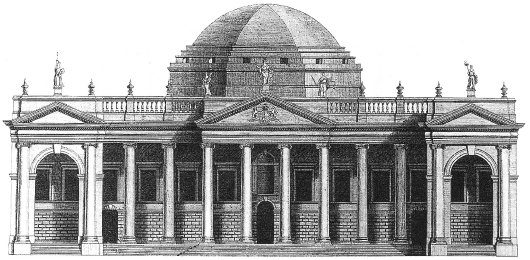
The Houses of Parliament, Dublin
The Physical Incarnation of Ireland’s Golden Age
THE OLD HOUSES OF PARLIAMENT in Dublin are probably at the top of my list of favourite buildings in the world. Now the headquarters of the Bank of Ireland, it has a long and varied history, and its exterior composition is one of surprising unity for a structure the components of which were designed by three architects. It is supposedly the first purpose-built parliament building in the world, and stands on the site of Chichester House, a stately home adapted for use by the Irish Parliament from the 1600s onwards.
The location, with a history dating back centuries, is just south of the Liffey river upon what was then known as Hoggen Green. A nunnery existed on the site which was supressed during Henry VII’s Dissolution of the Monasteries. A large private house was then built on the site, set back from the street, eventually known as Chichester House. (It likely incorporated some of the old convent’s structure). Among the esteemed inhabitants of the house were Sir George Carew, sometime Lord President of Munster, Sir Arthur Chichester, after whom the house was named, and the Anglican Bishop Edward Parry is known to have had a lease on the place during his lifetime.
The building must have been seen as holding some public significance, not only because it was located adjacent to the University of Dublin (of which Trinity College is the sole constituent institution), but it was home to the Irish Law Courts for a time beginning with the Michaelmas legal term of 1605. Towards the end of the seventeenth century, no later than October 1692, the Irish parliament began to meet at Chichester House on College Green.
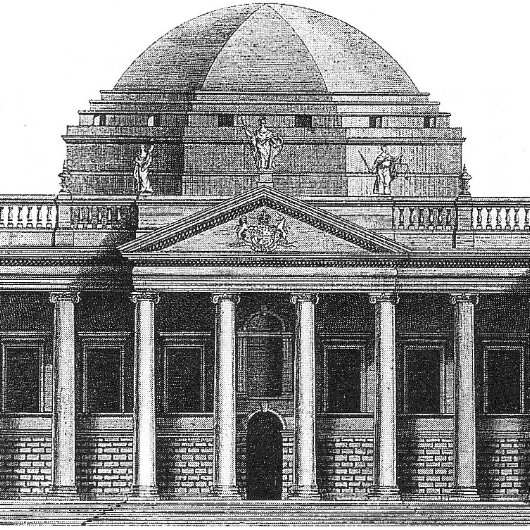
The first recorded meeting of the Parliament of Ireland was in 1264, making it ostensibly older than the English Parliament if one counts from de Montfort’s Parliament of 1265. (More reasonably, we might count the Oxford Parliament of 1258 as England’s “first”). Admittedly, the Parliament was born out of the extended Anglo-Norman domination of Ireland, and Poynings’ Law of 1494 meant that all acts had to receive approval from England before becoming law. Alongside the Protestant Revolution in England, Protestantism was made the state religion in Ireland. Nonetheless, Irish Catholics were actually allowed to vote for the Irish House of Commons (though not stand for election) and take seats in the Irish House of Lords until they were explicitly banished in 1728.
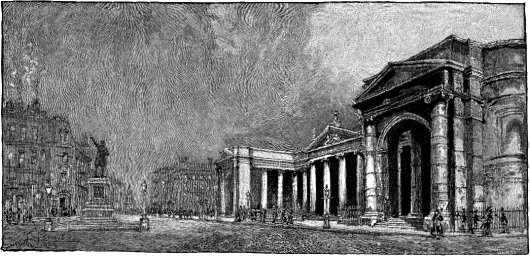
With growing confidence as an institution, the Parliament of Ireland in 1727 voted to tear down Chichester House and construct what is probably the first purposely-built parliament building in the world. They commissioned one of their own number, Edward Lovett Pearce MP, well known as the leading proponent of Palladian architecture in Ireland. Parliament repaired to the Blue Coat School north of the Liffey while the foundation stone of the new structure was laid on February 3, 1729.
As the eighteenth century proceeded, the Anglo-Irish aristocracy who dominated the Irish Parliament began to seek greater freedom from the British Parliament in Westminster. Through the efforts of the great reformer Henry Grattan, the Parliament of Great Britain was persuaded to allow the repeal of Poynings’ Law in order to appease the growing Irish discontent. With the “Constitution of 1782”, as it was known, Ireland’s legislative independence was restored.
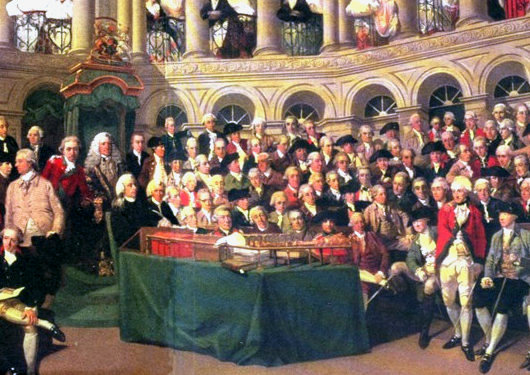
Henry Grattan, towards the right, in the red uniform, addressing parliament.
“I found Ireland on her knees,” Grattan proclaimed. “I watched over her with a paternal solicitude; I have traced her progress from injuries to arms, and from arms to liberty. Spirit of Swift, spirit of Molyneux, your genius has prevailed! Ireland is now a nation!”
Ireland’s gentry and aristocracy in the Commons and the Lords used their newfound freedom from Britain to adopt a program of moderate, evolutionary reform with the aim of stabilizing the divided nation. Most importantly, by the actions of this Protestant elite the freedom of the Catholic Church was gradually extended. Catholics were once again allowed to vote for the Commons from 1793. In 1795, George III, King of Ireland, exhibited his munificence towards his loyal Roman Catholic subjects by establishing St. Patrick’s College at Maynooth as a Catholic seminary. The land for the college donated by the (Protestant) Duke of Leinster. The seminary continued to be funded by the officially Protestant government until 1869, when the (Anglican) Church of Ireland was disestablished, removing Protestantism as the official state religion.
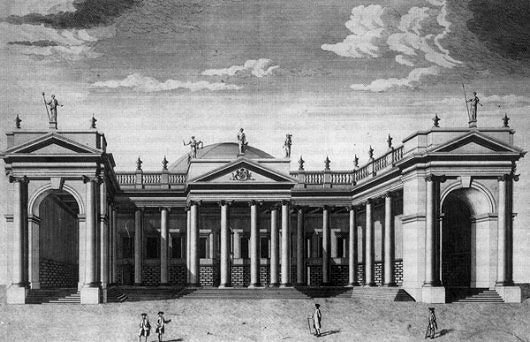
The façade and dome of Pearce’s original structure.
Pearce’s creation was fronted by an E-shaped Ionic collonade and portico facing what by then became known as College Green. What is somewhat odd, perhaps even off-kilter, about Pearce’s plan is the prominence it gives to the House of Commons, presumably at the expense of the House of Lords. The Commons chamber was on a direct axis with the front entrance while the Lords were pushed off the axis towards the east. This may have reflected the fact that Pearce was himself a member of the Commons, but it is also probable that William Connolly, the powerful Speaker of the House as well as Pearce’s political mentor, played a part in this seemingly inappropriate architectural distinction.
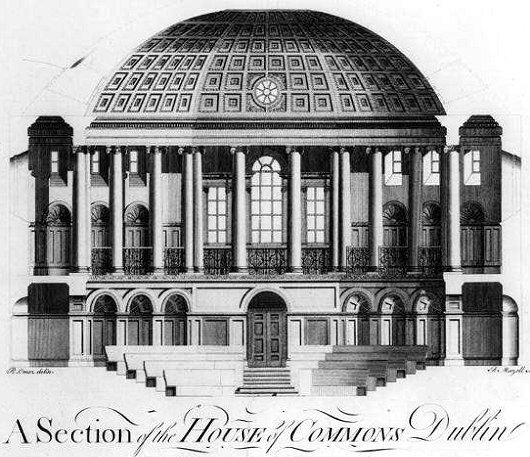
This inbalance is in contrast to the later Houses of Parliament at Westminster designed by Pugin and Barry, in which the Commons and the Lords are given virtually equal distinction in terms of the plan. Somewhat ironically, Pugin’s parliament, which has no real main façade, was designed to look as if it was constructed at different time periods (albeit with the external style all the same), though in reality except for Westminster Hall and some basements and crypts the entire structure was completed by a single architectural duo working at one time. The Irish Parliament building, meanwhile, was constructed by three architects at three different times (though all within the same century) yet has been made to appear as if composed as a whole.
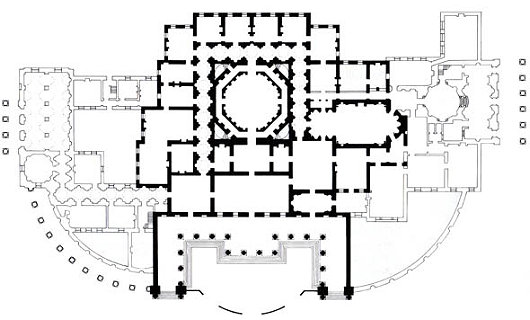
The plan of the building, with the walls of Pearce’s original structure shown in bold, the later additions lighter.
The House of Commons chamber was the centrepiece of the interior. It was octagonal, with the debating chamber divided from the visitors’ gallery by a collonade. Students from neighbouring Trinity College were afforded the right of entry to the gallery if wearing their academic gowns, though the privilege was repealed in 1795 by Speaker Foster.
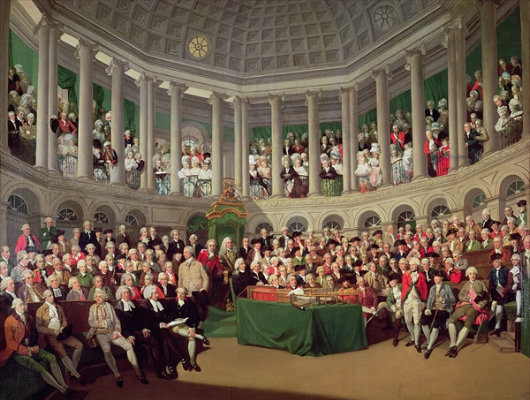
A painting of the Irish House of Commons assembled in 1780.
Though not short of classical white ornamentation, the Commons chamber retained green for the walls and other decoration and furniture, as the complementary red was used for Lords chamber. Thus began the precedent of daughter parliaments in the Empire and Commonwealth adopting the lower house green and upper house red typical in parliamentary design. (Though it should be noted that the Irish parliament was not a daughter parliament to Westminster, as it was of independent origin).
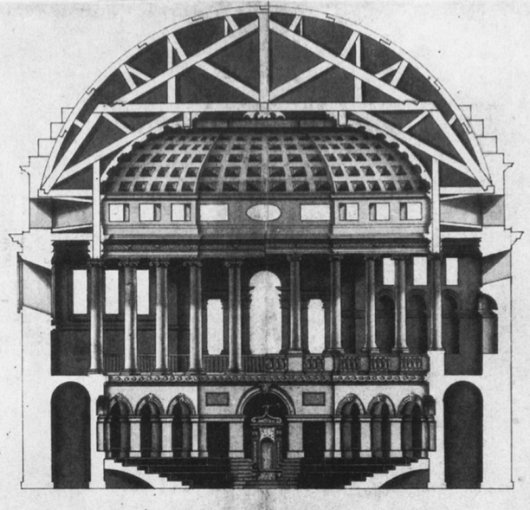
Alas, the magnificent chamber burned in 1792 and was rebuilt to a different plan in 1796, just a few years before the Act of Union.
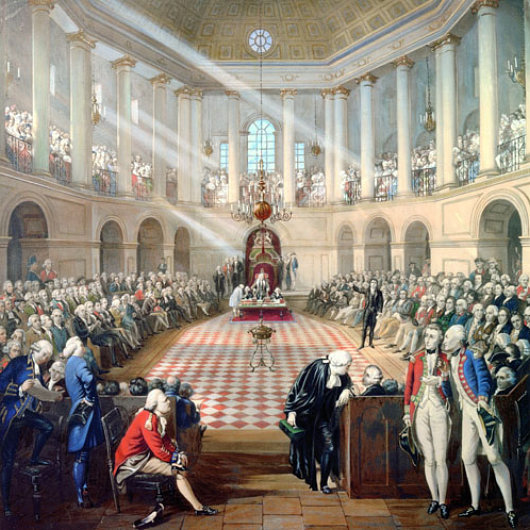
An incorrect colourisation of a print of the last meeting of the Irish Parliament.
On a side note, a Cusack once held the office of Speaker of the Irish House of Commons, though Sir Thomas Cusack (previously a Justice and afterwards Master of the Rolls) was elected to the position in 1541, long before the body occupied Chichester House and its procedent. (Sir Thomas was shamefully deeply involved in implementing Henry’s Dissolution of the Monasteries in Ireland).
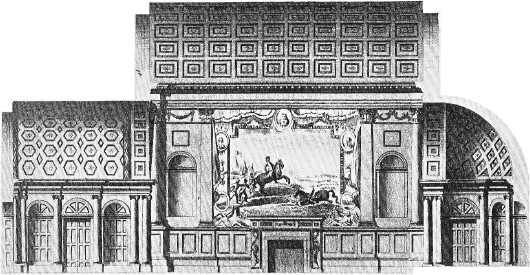
The Lords chamber for the Peerage of Ireland, like the Commons chamber, featured a coffered ceiling though, unlike the lower house, the ceiling was arched rather than domed. The chamber featured a raised dais in a recessed alcove on one end upon which sat the viceregal throne. The flanking walls of the House of Lords featured, above fireplaces, two tapestries by John van Beaver depicting William III’s victory at the Battle of the Boyne.
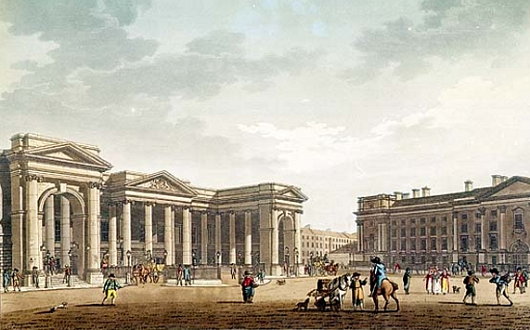
The Parliament House was joined on College Green by the West Front of Trinity College, constructed between 1752 and 1759. The construction of the West Front as well as the Dining Hall, Chapel, and othe structures behind it were lavishly funded by the Parliament. The result was that Trinity College in Dublin had buildings grander than any Oxford or Cambridge college of the day.
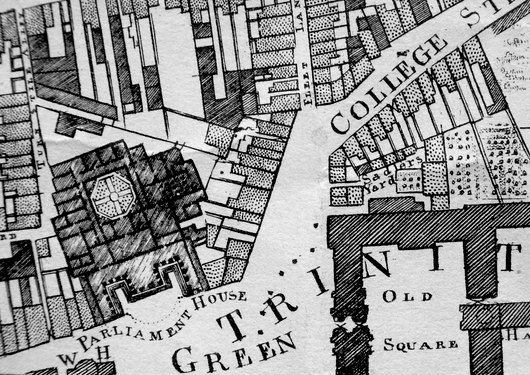
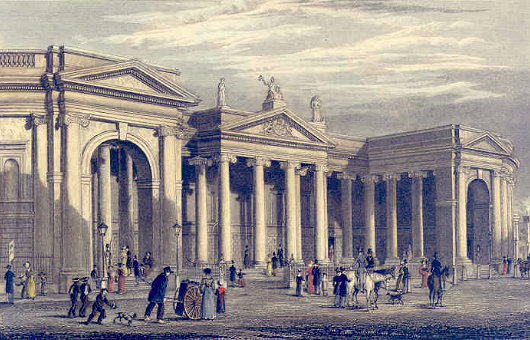
Like other prominent Dublin buildings of the age, Parliament House featured statuary by the sculptor Edward Smyth. At the summit of the façade’s central pediment was Hibernia, the allegorical personification of Ireland using the country’s Latin name. Hibernia was joined at the western base of the pediment by Fidelity, with Commerce completing the triumvirate on the eastern base.
The Lords desired an extension of their wing providing for a more suitable and exclusive entrance portico, and they commissioned noted Dublin architect James Gandon to design the eastern extension in 1785. Another extension, designed by Robert Parke in 1787, was added on the west side with a complementary portico built on a somewhat smaller scale.

The building, however, was not quite complete until the great sweeping curved walls which lend so much drama to the august building’s exterior were added. Gandon had built a curved plain curtain wall to cover up the awkwardness of how his extension met Pearce’s original building. Parke linked his structure’s frontage to Pearce’s by means of an ionic collonade. The result was generally deemed unattractive, and so both Parke’s collonade and Gandon’s plain curtain wall were replaced with matching curtain walls featuring Ionic columns with intervening niches.
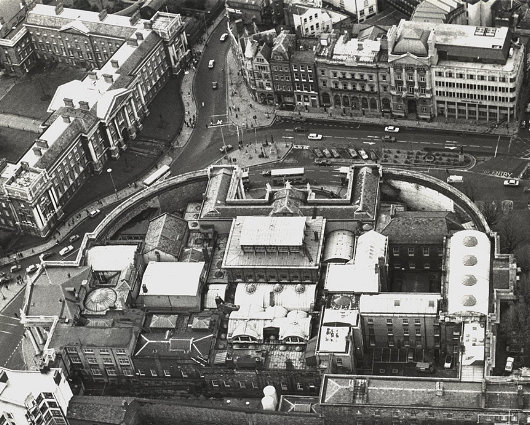
This aerial photo shows the haphazard nature of the building’s interior plan, masked by the curved curtain walls flanking the main façade.
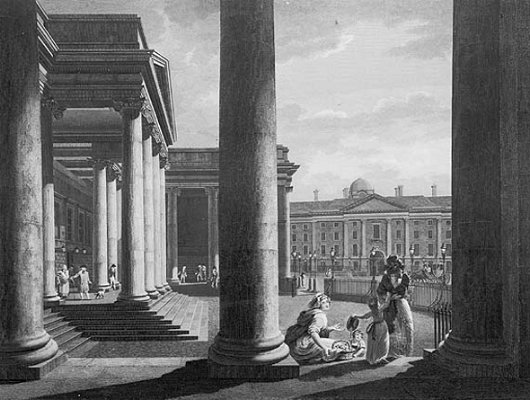
With the Parliament’s freedom, Dublin once again became a city of great importance instead of a mere administrative backwater. Merchants and the aristocracy built grand houses in and around the city to participate in the social season. Between January and St. Patrick’s Day in March, the Viceroy of Ireland presided over state balls in the Viceregal Apartments of Dublin Castle, coinciding (for the most part) with the parliamentary session.
Ireland’s golden age, however, was not to last long. Alongside the process of Ireland regaining legislative independence, the horrors of the Revolution were regnant across the sea in France, and the revolutionary regime there attempted to export its evil ideology. In 1798, the Society of the United Irishmen, a radicalized band of angry reformers, launched a violent republican revolution inspired by the French. The rebellion was eventually suppressed but its widespread nature spread alarm at the state of affairs in Ireland. In the backlash, the British government was convinced that the only solution was the union of Great Britain and Ireland, along similar lines as the Union of Scotland and England in 1707. The initial attempt to get the Irish parliament to abolish itself and agree to union with Great Britain failed, but after a massive campaign of bribery and inducements, the Act of Union was passed in 1800. On January 1, 1801, the Kingdom of Great Britain and the Kingdom of Ireland joined, and the United Kingdom was born.
The old Houses of Parliament were sold to the Bank of Ireland, on the sole condition that it not be used for political purposes. Accordingly, the House of Commons was demolished and replaced with a banking hall.
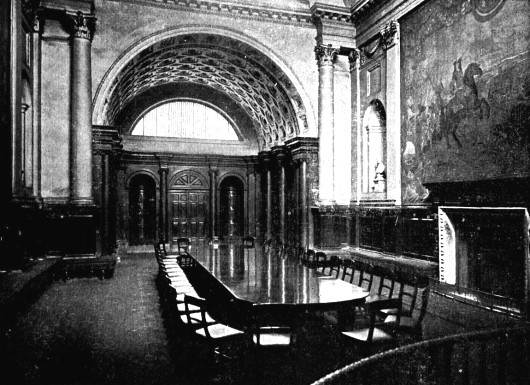
The Lords chamber, however, escaped harm by being assigned a new use as the Bank of Ireland’s boardroom. The above photograph was taken during this usage.
Two hundred years the building is still in the hands of the Bank of Ireland. The House of Lords chamber is open to the public during normal business hours. Inside the mostly-restored chamber is the woolsack on which the Lord Chancellor of Ireland once sat, as well as the mace of the Irish House of Commons, unused by today’s Dail Éireann, thanks to the republican reluctance to recall Ireland’s monarchic past.
The Bank of Ireland is a fine building and it’s Ireland’s loss that it no longer houses the nation’s parliament. The misguided would say that it’s Ireland’s loss that it is no longer part of the United Kingdom, but, numerous other considerations aside, both countries have reached such low ebbs in the history of parliamentary government that it’s hard to justify that. Perhaps with a tinge of irony, the Oireachtas na hÉireann (Ireland’s current parliament) sits in Leinster House, itself built as a home for the Duke of Leinster – a member of Ireland’s House of Lords.

Search
Instagram: @andcusack
Click here for my Instagram photos.Most Recent Posts
- Sag Harbor Cinema March 26, 2025
- Teutonic Takeover March 10, 2025
- Katalin Bánffy-Jelen, R.I.P. March 3, 2025
- Substack Cusackiensis March 3, 2025
- In the Courts of the Lord February 13, 2025
Most Recent Comments
Book Wishlist
Monthly Archives
Categories



A wonderful article, Andrew. Thank you. I have visited this building and it really is wonderful.
Fascinating history and beautiful building. It’s been modeled on Google Earth for further viewing here: http://bit.ly/93fV1k
Thank you for including the aerial view
“its exterior composition is one of surprising unity”
Yet only unified, as you note, once wrapped with stone, much as Christo wraps indiscriminately with cloth
Christo’s wrappings are indiscriminate and silly. A facade, in contrast, is an institution’s public face and part of the street’s definition. Santa Maria della Pace in Rome handles the problem in a similar way.
This building’s facade certainly seems effective in concealing the architectural sausage-making within. Its ability to shield the public from the legislative process is less clear.
Santa Maria della Pace’s facade appears, in contrast, to represent the shape of the space directly inside.
Great article. Found this very fascinating.
Thank you for such an informed article on our iconic building. It’s a pity I couldn’t find an official site government with such detail, especially as my daughter is studying this building for her leaving cert. So I’m very grateful for the history and accompanying images.
Andrew,
Interesting that “Mary Kelly” should reply! Your Grandmother
always was a good one to answer regarding a good article, but from
the beyond?
God Bless!
Col C
Without luck I am trying to locate details and the source of the elevation of the House of Commons you reproduce, not from the Omer 1767 engravings, but shown above just after the Wheatley painting.
Many thanks,
A.S. Marks